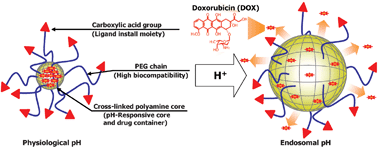A pH-sensitive PEGylated nanogel was prepared by emulsion copolymerization of 2-(N,N-diethylamino)ethyl methacrylate (EAMA) with heterobifunctional poly(ethylene glycol) bearing a 4-vinylbenzyl group at the α-end and a carboxylic acid group at the ω-end (CH2![[double bond, length as m-dash]](https://www.rsc.org/images/entities/char_e001.gif) CH–Ph–PEG–COOH; Mn = 8000) in the presence of potassium persulfate and ethylene glycol dimethacrylate (1.0 mol%) as cross-linker. The loading of the anticancer drug doxorubicin (DOX) into the pH-sensitive PEGylated nanogel was carried out by means of a solvent evaporation method, and the amount of DOX loaded into the PEAMA core was found to be 26 wt%. Furthermore, the DOX-loaded, pH-sensitive PEGylated nanogel showed almost no initial burst release of the DOX under physiological pH, whereas significant release of DOX from the pH-sensitive PEGylated nanogel was observed at the endosomal pH. The antitumor activity of the DOX-loaded, pH-sensitive, PEGylated nanogel against the human breast cancer cell line MCF-7 was lower than that of free DOX. On the other hand, the antitumor activity of the DOX-loaded, pH-sensitive, PEGylated nanogel against the human hepatoma cell line HuH-7, which is a natural drug-resistant tumor line, was superior to that of both free DOX and the DOX-loaded, pH-insensitive, PEGylated nanogel. Using fluorescence microscopy, pH-sensitive PEGylated nanogel in HuH-7 cells was found to be initially localized within the endosome and/or lysosome, with subsequent release of DOX from the nanogel in response to the endosomal pH, and ultimately, diffusion via the cytoplasm into the cell nucleus. These findings suggest that the pH-sensitive PEGylated nanogel represents a promising nano-sized carrier for anticancer drug delivery systems in vivo.
CH–Ph–PEG–COOH; Mn = 8000) in the presence of potassium persulfate and ethylene glycol dimethacrylate (1.0 mol%) as cross-linker. The loading of the anticancer drug doxorubicin (DOX) into the pH-sensitive PEGylated nanogel was carried out by means of a solvent evaporation method, and the amount of DOX loaded into the PEAMA core was found to be 26 wt%. Furthermore, the DOX-loaded, pH-sensitive PEGylated nanogel showed almost no initial burst release of the DOX under physiological pH, whereas significant release of DOX from the pH-sensitive PEGylated nanogel was observed at the endosomal pH. The antitumor activity of the DOX-loaded, pH-sensitive, PEGylated nanogel against the human breast cancer cell line MCF-7 was lower than that of free DOX. On the other hand, the antitumor activity of the DOX-loaded, pH-sensitive, PEGylated nanogel against the human hepatoma cell line HuH-7, which is a natural drug-resistant tumor line, was superior to that of both free DOX and the DOX-loaded, pH-insensitive, PEGylated nanogel. Using fluorescence microscopy, pH-sensitive PEGylated nanogel in HuH-7 cells was found to be initially localized within the endosome and/or lysosome, with subsequent release of DOX from the nanogel in response to the endosomal pH, and ultimately, diffusion via the cytoplasm into the cell nucleus. These findings suggest that the pH-sensitive PEGylated nanogel represents a promising nano-sized carrier for anticancer drug delivery systems in vivo.
![[double bond, length as m-dash]](https://www.rsc.org/images/entities/char_e001.gif) CH–Ph–PEG–COOH; Mn = 8000) in the presence of potassium persulfate and ethylene glycol dimethacrylate (1.0 mol%) as cross-linker. The loading of the anticancer drug
CH–Ph–PEG–COOH; Mn = 8000) in the presence of potassium persulfate and ethylene glycol dimethacrylate (1.0 mol%) as cross-linker. The loading of the anticancer drug 

 Please wait while we load your content...
Please wait while we load your content...